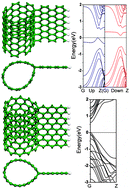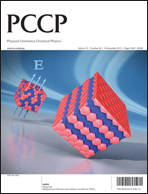Hybrid nanotube–graphene junctions: spin degeneracy breaking and tunable electronic structure†
Abstract
Hybrid carbon nanostructures have attracted enormous interest due to their structural stability and unique physical properties. Geometric and physical properties of a carbon nanotube (CNT)–graphene nanoribbon (GNR) hybrid system were investigated via first-principles density functional theory (DFT) calculations. The nanotube–graphene junction (NTGJ), where the GNR directly links to the CNT by covalent bonds, shows novel electronic dependence on the structural parameters of the building-blocks, such as chirality, nanotube diameter and width of the nanoribbon. For an armchair NTGJ, a small band gap opens up representing asymmetrical spin-up and spin-down bands. However, zig-zag NTGJ shows direct semi-conducting characteristics with a tunable band gap ranging from zero to 0.6 eV. Interestingly, the value of the band gap follows the specific width and diameter dependent oscillations, namely the 3p − 1 principle. Transition-state results reveal the formation of NTGJs is exothermic and has a low energy-barrier. In addition, nanotube–graphene–nanotube junctions or namely dumbbell NTGJs were also studied, which exhibits similar properties with single NTGJ.


 Please wait while we load your content...
Please wait while we load your content...